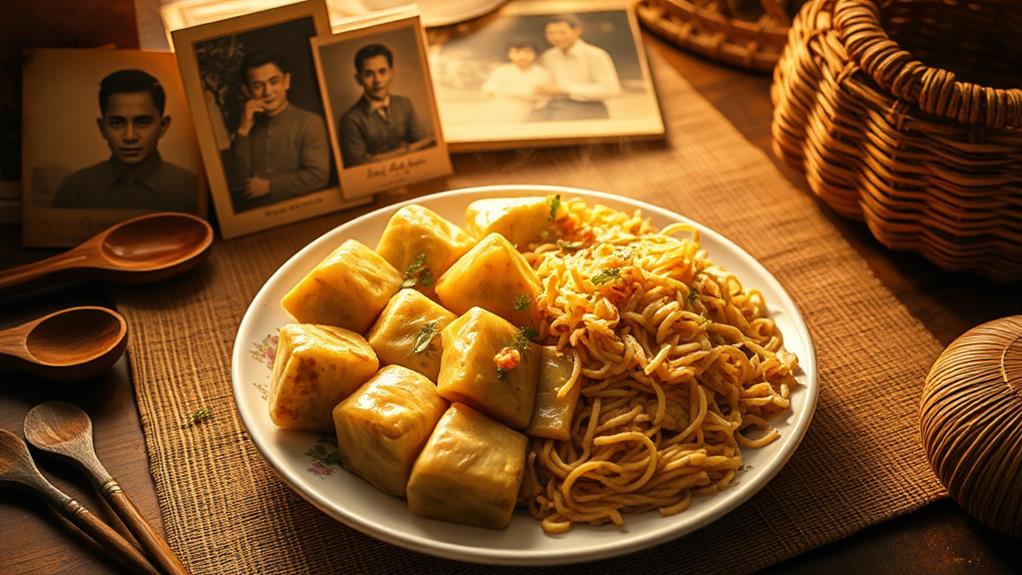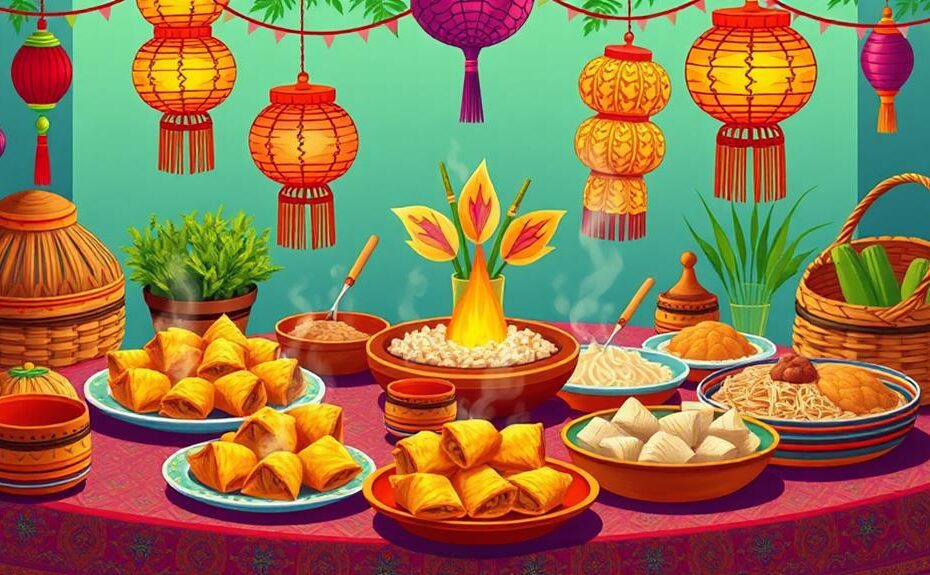Lumpia and pancit are cultural representations of the Philippines' rich history and heritage. They have evolved through cultural fusion, adaptation, and innovation.
Lumpia comes in a variety of flavors. For example, there's the spicy Lumpiang Dynamite and the sweet Turon.
Pancit is a symbol of long life. It's often served at birthdays instead of cake.
This tradition is rooted in the Filipino culture, where noodles symbolize long life and good health.
Flavorful Fusion of Lumpia Varieties

Lumpia, the Filipino version of spring rolls, offers a diverse array of flavors and textures that cater to various tastes and preferences.
One popular variety is Lumpiang Shanghai, filled with ground pork or beef, which has earned a high rating of 4.9/5 from Taste Atlas in 2021. This variety showcases the rich flavors of meat fillings.
For a savory taste and crunchy texture, Lumpiang Togue is a street food favorite filled with sautéed bean sprouts, pork, or tofu. This option highlights the use of vegetables and alternative protein sources.
Lumpiang Dynamite is an adventurous option, packing a punch with its long green chili pepper filling. This variety is ideal for those who enjoy spicy food.
For those with a sweet tooth, Turon is a crispy dessert lumpia filled with ripe Saba bananas and sugar, sometimes paired with jackfruit. This option demonstrates the versatility of lumpia as a dessert.
If you're looking for a healthier option, Lumpiang Sariwa uses fresh ingredients and egg roll wrappers, served with a refreshing peanut sauce. This variety showcases the use of fresh ingredients and healthier cooking methods.
With so many flavorful fusions, you're sure to find a lumpia that suits your taste buds.
Pancit Traditions and Cultural Significance
Pancit: A Traditional Filipino Dish Symbolizing Long Life
Pancit is a traditional Filipino dish that symbolizes long life, making it a staple at birthday celebrations. Instead of cake, pancit is often served as the main attraction, highlighting the importance of food in Filipino culture.
Connecting with Cultural Heritage through Pancit
When you sit down to enjoy a plate of pancit, you're not just savoring a delicious meal – you're connecting with your cultural heritage.
Pancit is typically prepared with rice noodles, vegetables, and proteins like shrimp, chicken, or pork. There are popular types of pancit, such as Pancit Bihon, made with thin rice noodles, and Pancit Canton, which uses thick wheat noodles and is versatile for various recipes.
Regional Pancit Specialties and Cultural Influences
As you explore the different regions of the Philippines, you'll discover unique pancit specialties that showcase local ingredients and culinary influences.
The Chinese influence on Filipino food is evident in the use of wheat noodles in Pancit Canton. By indulging in this traditional Filipino dish, you're strengthening family bonds and honoring your cultural identity.
The Evolution of Filipino Cuisine

Filipino cuisine has evolved over centuries, shaped by the convergence of diverse cultural influences. This unique fusion is a result of Chinese, Spanish, and American influences, which have blended together to create a distinct culinary identity.
Adaptation is key in Filipino cuisine. The introduction of lumpia by Chinese immigrants around 900 A.D. marked the beginning of its integration into Filipino culinary traditions.
For example, the lumpia wrapper was adapted to local tastes, incorporating ingredients like soy sauce and calamansi.
Filipino cuisine is known for its ability to innovate, often incorporating local produce and flavors. This has led to new variations like vegan lumpia and fusion recipes that showcase the creativity of Filipino cooks.
For instance, Filipino cooks have created vegan lumpia by replacing traditional pork or beef with plant-based ingredients.
In Filipino culture, food is a symbol of celebration. Food plays a significant role in celebrations, and dishes like pancit are often served at birthdays to symbolize long life.
This highlights the cultural significance of food in reinforcing familial bonds and cultural identity.
Unconventional Delicacies in Filipino Culture
Filipino cuisine is known for its creativity and resourcefulness, as seen in its unconventional delicacies. Lumpia, a popular Filipino dish, has unconventional versions like Lumpiang Hubad, which is essentially a naked lumpia without the wrapper. This flexibility in preparation showcases the creativity of Filipino cuisine.
Filipino cooks are skilled at utilizing every part of the animal, as demonstrated by dishes like sisig, made from pig's head, and dinuguan, a stew made from pig's blood. These dishes highlight the resourcefulness of Filipino cooks in minimizing food waste.
Balut, a hard-boiled duck embryo, is a unique delicacy typically enjoyed warm with rock salt or vinegar. To prepare it, simply bring to a boil, then season with salt and a dash of vinegar.
Filipino dishes often blend Chinese influences, like the use of fried rice and green onions, with traditional flavors.
When trying these unconventional delicacies, you'll experience the bold flavors and rich cultural heritage of the Philippines.
What Cultural Significance Do Lumpia and Pancit Have in Filipino Cuisine?
Lumpia and pancit hold great cultural significance in Filipino cuisine. These dishes are often found in family gatherings, celebrations, and traditional festivities. The variations of pancit canton, a popular noodle dish, showcase the diverse influences and flavors that make Filipino cuisine unique and cherished worldwide.
Food as a Symbol of Heritage

Through the lens of food, the rich cultural heritage of the Philippines comes into focus. Filipino cuisine is more than just a source of sustenance – it's a symbol of heritage, community, and cultural identity.
Food represents Filipino heritage in three significant ways:
Fusion of cultures: The Philippines' cultural heritage is reflected in its cuisine, which is shaped by diverse influences. For example, lumpia's savory and sweet variations are a result of the country's history with Hokkien and Fujian immigrants, as well as Spanish and American colonizers.
Community bonds: The preparation of traditional dishes like lumpia often involves family gatherings, emphasizing the importance of community bonds. These gatherings also facilitate the transmission of culinary traditions across generations.
Symbolism in celebrations: Food plays a significant role in Filipino celebrations, with certain dishes serving as symbols of important milestones. For instance, pancit, particularly bihon, is traditionally served at Filipino birthday celebrations as a symbol of long life.
Frequently Asked Questions
What Is the Cultural Significance of Lumpia?
Lumpia holds a significant place in Filipino cultural heritage. Introduced by Chinese immigrants, lumpia symbolizes the fusion of culinary traditions in the Philippines.
During festive occasions like Christmas, lumpia brings people together, fostering connections and shared experiences. For instance, families and friends gather to make and share lumpia, creating a sense of community and togetherness.
Lumpia's versatility in fillings and recipes represents the country's adaptability and rich history. With various fillings such as vegetables, meat, or seafood, lumpia can be tailored to suit different tastes and preferences.
This adaptability reflects the Philippines' history of cultural exchange and blending of traditions. As a staple in Filipino celebrations and daily life, lumpia plays a significant role in shaping the country's culinary identity.
What Is a Fun Fact About Lumpia?
Lumpia has a rich history that spans over a thousand years. It originated in 900 A.D. and has evolved into various recipes through cultural exchange and creativity.
Each recipe is a testament to the Filipino people's adaptability and resourcefulness.
Lumpia is a staple in Filipino cuisine, made with ingredients like ground pork, beef, and vegetables. Its popularity has transcended borders, allowing it to be enjoyed by people from different cultures.
This Filipino favorite has gained international recognition, with its unique flavors and crispy texture making it a standout dish.
What Is a Fun Fact About Lumpia?
Lumpia has a rich history dating back to 900 A.D. when Hokkien and Fujian immigrants introduced it to the Philippines. This introduction led to the creation of various lumpia types, such as Lumpiang Shanghai, which can be filled with ground pork or beef, and sweet Turon, which is filled with ripe bananas and sugar.
Lumpia is typically enjoyed with a dipping sauce, often a mix of soy sauce and calamansi.
This beloved snack is a staple at Filipino celebrations, especially during holidays like Christmas, where families bond over cooking and sharing lumpia recipes.
What Ethnicity Is Lumpia From?
Lumpia is of Chinese origin. Specifically, it was introduced to the Philippines by Hokkien and Fujian immigrants around 900 A.D.
Over time, Filipino Lumpia evolved with local ingredients and preparation methods, resulting in unique variations.
One example is Lumpiang Shanghai, which is typically filled with a mixture of vegetables and sometimes meat or seafood.
Another example is Lumpiang Togue, which is filled with bean sprouts and often served as an appetizer or snack.
